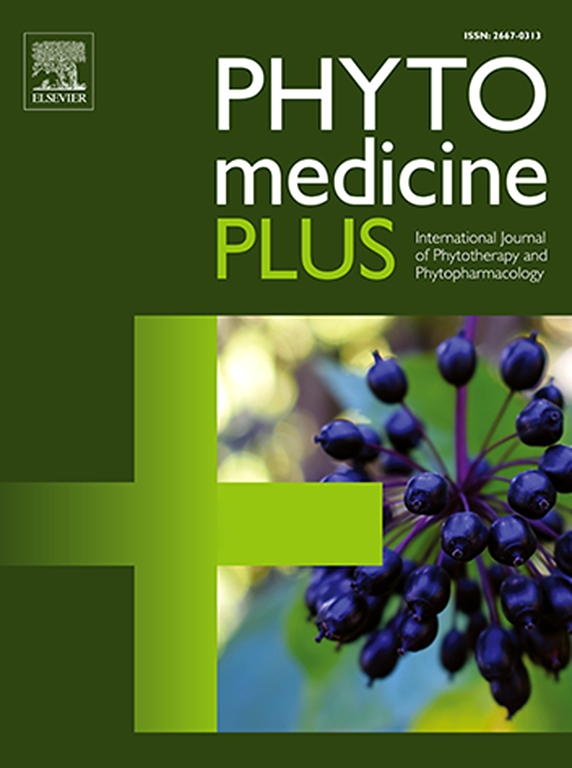Phytochemical composition and antioxidant properties of Canarium odontophyllum (Sarawak Olive): A seasonal fruit from Borneo, East Malaysia
Q3 Pharmacology, Toxicology and Pharmaceutics
引用次数: 0
Abstract
Background
Canarium species are reported rich of polyphenol, alkaloids, flavones, and saponins compounds. Canarium odontophyllum from Borneo's variety, on the other hand is remaining unclear especially on the antioxidant activity towards radicals.
Purpose
To investigate phytochemical composition and antioxidant properties of C. odontophyllum.
Methods
Antioxidant properties were evaluated using 2,2-diphenyl-1-picrylhydrazyl-hydrate (DPPH) assay, 2,2′-azino-bis(3-ethylbenzthiazoline-6-sulphonic acid) (ABTS) assay, and ferric-reducing antioxidant power (FRAP) assay with different polarity of extraction solvents (methanol, acetone and hexane). The phytochemical composition was determined by Liquid Chromatography Mass Spectrometry Quadrupole Time of Flight (LCMS-QTOF).
Results
Acetone showed the highest scavenging activity in the DPPH (0.0307 mg/ml) and FRAP (3.926 mg/ml) assays, while hexane exhibited the highest activity in the ABTS assay (0.119 mg/ml). The LCMS-QTOF chromatogram identified 22 potential compounds. Among these, the major compounds oleamide (10.49 %) and emmotin A (7.23 %) have previously been reported to exhibit antioxidant activity. Other health-beneficial compounds were also found, such as palmitic amide (2.46 %), deoxymiroestrol (6.23 %), and N-Cyclohexanecarbonylpentadecylamine (48.92 %), which are important in preventing metal corrosion, regulating hormones, and distinguishing between N-palmitoylethanolamine-hydrolyzing acid amidase (NPAA) and fatty acid amide hydrolase (FAAH), respectively.
Conclusion
The results indicate that C. odontophyllum shows a promising potential an alternative drug in pharmaceutical developments.

砂拉越橄榄(Canarium odontophyllum)的植物化学成分和抗氧化特性:一种产自马来西亚东部婆罗洲的时令水果
据报道,canarium属植物富含多酚、生物碱、黄酮和皂苷类化合物。另一方面,来自婆罗洲品种的Canarium odontophyllum仍不清楚,特别是对自由基的抗氧化活性。目的研究牙齿草的植物化学成分及抗氧化性能。方法采用2,2-二苯基-1-吡啶肼水合(DPPH)法、2,2 ' -氮基-二(3-乙基苯并噻唑-6-磺酸)(ABTS)法、以及不同极性萃取溶剂(甲醇、丙酮和己烷)下的铁还原抗氧化能力(FRAP)法评价其抗氧化性能。采用液相色谱-质谱四极杆飞行时间(LCMS-QTOF)测定植物化学成分。结果sacone对DPPH (0.0307 mg/ml)和FRAP (3.926 mg/ml)的清除率最高,己烷对ABTS (0.119 mg/ml)的清除率最高。LCMS-QTOF图谱鉴定出22个潜在化合物。其中,主要化合物油酰胺(10.49%)和情绪素A(7.23%)已被报道具有抗氧化活性。此外,还发现了棕榈酰胺(2.46%)、脱氧雌雌醇(6.23%)和n -环己烷羰基五烷基胺(48.92%)等有益健康的化合物,它们在防止金属腐蚀、调节激素、区分n -棕榈酰乙醇胺水解酸酰胺酶(NPAA)和脂肪酸酰胺水解酶(FAAH)等方面具有重要作用。结论齿根草是一种很有潜力的替代药物。
本文章由计算机程序翻译,如有差异,请以英文原文为准。
求助全文
约1分钟内获得全文
求助全文
来源期刊

Phytomedicine Plus
Medicine-Complementary and Alternative Medicine
CiteScore
3.70
自引率
0.00%
发文量
178
审稿时长
81 days
期刊介绍:
 求助内容:
求助内容: 应助结果提醒方式:
应助结果提醒方式:


